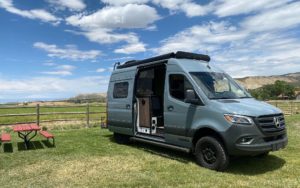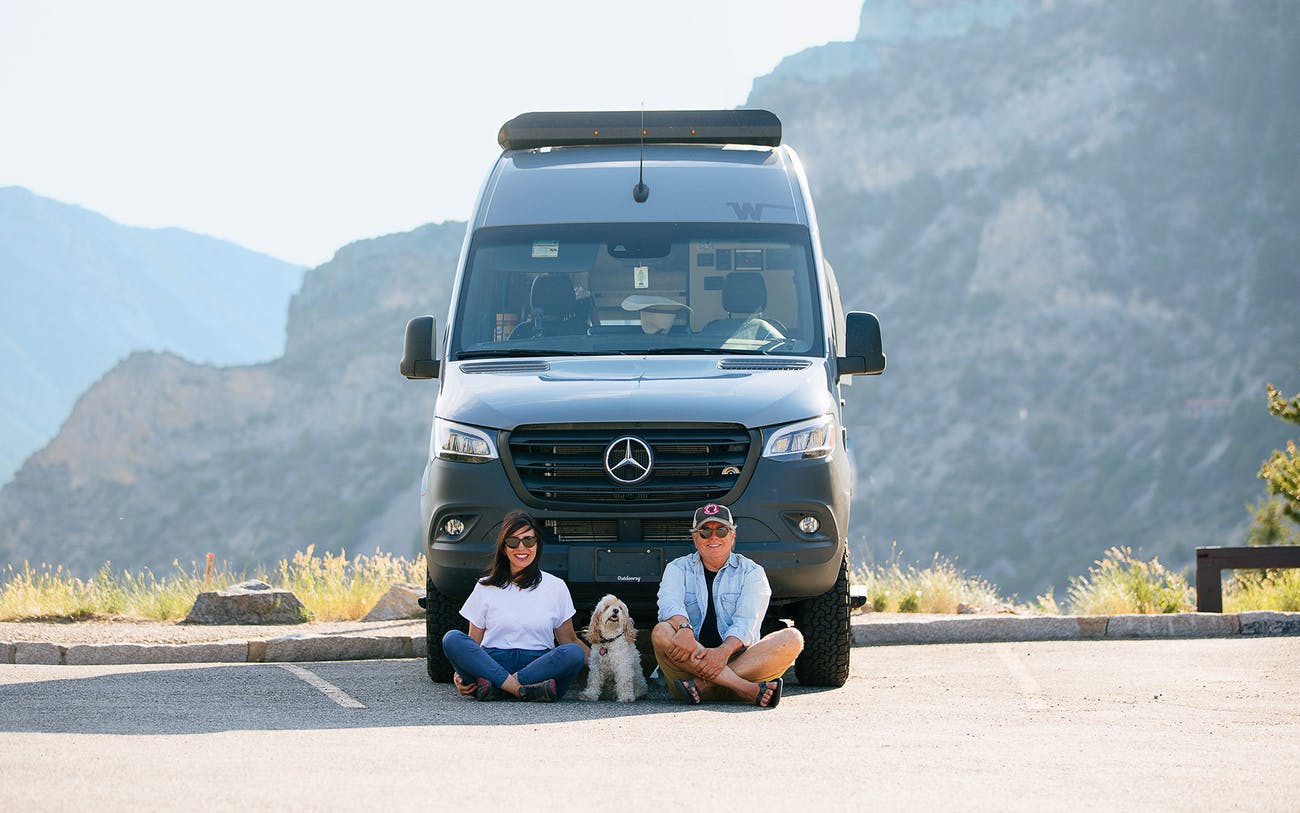 When demand surged for pandemic-friendly RVs and camper vans, Austin-based rental company Outdoorsy was ready to capitalize on the trend.
When demand surged for pandemic-friendly RVs and camper vans, Austin-based rental company Outdoorsy was ready to capitalize on the trend.
Jeff Cavins will never forget a prospective investor’s words from six years ago: “It’ll be nothing but crickets chirping on your website.” Cavins and his partner in business and life, Jennifer Young, were rejected by no fewer than sixty investors when they first started pitching their idea of a peer-to-peer camper-van rental marketplace called Outdoorsy in 2015. Some shortsighted tech bros in Silicon Valley and New York even escorted the pair out of meeting rooms only fifteen minutes into the duo’s hour-long presentation. The doubt in investors’ voices was thick: Who would want to spend their vacation in a stranger’s motor home?
A lot of people, as it turns out. Young and Cavin’s belief in Outdoorsy hinged on market research, which they say revealed that more than 20 million recreational vehicles—RVs, pop-top campers, motor coaches, and Westfalias—in the U.S. and over 54 million worldwide sit idle in people’s driveways for an average of 350 days a year. Before Outdoorsy, RV renters had to sift through listings from local rental companies like Woody RV Rentals in Hutto, or national outfits such as Cruise America, the company notorious for wrapping its massive motor homes with pictures of national monuments, decals of dogs peeping out windows, and the 800-RV4-RENT phone number. The RV rental industry didn’t account for the millions of individual vehicle owners who, if given the opportunity, would lend their trailer or motor home to a family who could enjoy it in exchange for a little extra cash.
So, as their proof of concept, Austin transplants Cavins and Young immersed themselves in what RV acolytes call the freedom-on-four-wheels community. They quit their executive-level jobs—Cavins left a software company in San Francisco, and Young left her advertising job in Vancouver—and sold their homes and belongings. They packed a few duffel bags each and set out on an eight-month road trip across the U.S. in a newly purchased, 27-foot-long Airstream trailer. Finally untethered from their corporate lifestyles, having traded beige walls and fluorescent lights for nature’s wonders, they felt more at ease and connected to each other than ever before. “We feel the greatest when we are near an ocean or a mountain or a lake or something magnificent in nature,” Young says. “For me, it’s the closest thing to God.”
On the road, the couple met first-timers and seasoned campers; older and younger travelers; and a mother homeschooling her kids while road-tripping. “Jen would actually knock on the doors of people’s RVs,” Cavins says. “She’d go in with a legal pad and a pen, and sometimes those conversations would turn into two hours.” These folks were their future customers.
Now headquartered in Austin, Outdoorsy entered the sharing economy in 2015, after Cavins and Young took part in a Palo Alto incubator that helped them professionalize the RV marketplace and get off the ground. The company launched at an especially opportune time. That year, seven-year-old Airbnb hit 17 million stays, and six-year-old Uber reached $10 billion in rides. It was also a turning point for the outdoor recreation industry. The Bureau of Economic Analysis measured the industry for the first time as 2.2 percent of the nation’s GDP ($412 billion) in 2016. The #vanlife movement exploded thanks to Instagram. And the National Parks Service reported record-breaking numbers of visitors, with 307 million people stopping by in 2015 and 330 million in 2016.
During the first quarter of 2021, privately held Outdoorsy reported $1 billion in transactions. More than 37 million people across fourteen countries, including the U.S., Australia, and the United Kingdom, have used Outdoorsy to search through around 200,000 vehicles—Sprinter vans, teardrop trailers, truck campers, even converted school buses known as “skoolies”—that are available for their chosen locations and time frames. (In 2020, the average rental period was 6.4 days.) Renters have the option to drive the vehicles themselves or ask the owners to set them up at campgrounds. For a week in Big Bend National Park departing from Marfa, a vehicle that sleeps ten travelers would cost about $1,400. For a weekend of camping near Plano, a Mercedes Sprinter van would cost about $200 a night. For every reservation, owners keep 80 percent of the total cost and Outdoorsy gets the other 20 percent, plus a daily service fee from the renter, which ranges from $10 to $15 depending on the size of the rig. Both renters and owners are verified through a two-hundred-point identity and background check that evaluates criteria such as credit score and DMV history. To further protect owners, every transaction includes $1 million in insurance.
Alexei Andreev, cofounder and managing director of Autotech Ventures in Silicon Valley, was among Outdoorsy’s first angel investors. Even though he had never camped in an RV before, he saw promise in the untapped market. “It’s like Airbnb with a different underutilized asset, so it’s easy to apply this business model and understand how big it can be,” Andreev says.
One of the main reasons big-city investors balked was that they associated motor homes with poverty, Cavins says. Data show that at least a million Americans live in their recreational vehicles full time, but the line is blurry between those who would be unhoused if not for their vehicles and those who choose RVs for a new way of life. Either way, #vanlife isn’t necessarily the glamorous parade of ocean views and gourmet, organic campfire meals portrayed on social media. From Instagram influencers who support themselves by posing in tricked-out buses to folks who’ve moved into vans to lower their housing costs, vehicle dwellers have captivated the culture. Just ask Oscar voters, who nominated the 2020 film Nomadland, which follows a baby boomer who moves into her van out of necessity, for six Academy Awards. There’s an underbelly to the endless American road trip, and Outdoorsy’s clientele is only a small sliver in a diverse market.
In March 2020, like many businesses, Outdoorsy lost 100 percent of bookings and core clientele due to the pandemic. The places people visited in camper vans shut down—not just parks, but also events like the Bonnaroo Music & Arts Festival, NASCAR races, and Major League Baseball spring training. There was no way to replace the revenue. With the rest of the world in crisis, and nothing to do but wait, Young and Cavins launched a program to temporarily house medical professionals and other frontline workers. And when vacationers started looking for a COVID-safe way to travel, the company was perfectly poised. “Outdoorsy is the most COVID-positive company in our portfolio,” says Andreev, who has also invested in Lyft and the private charter bus booking site Bus.com.
Owners can list RVs, pop-top campers, motor coaches, Westfalias, and more on Outdoorsy’s marketplace.Courtesy of Outdoorsy
Many people turned to RVs as a new way to spend their summer vacations, away from others and quarantined within the safety of their own portable, confined spaces. The U.S. Department of the Interior even added Outdoorsy rentals to its campground-booking site, recreation.gov, as the camper-van marketplace for the national parks.
Others discovered the platform as a way to make up for lost income during the economic downturn. A Denver-based owner of B&B RV Rentals says he made nearly $2.4 million in the last year with the family-owned business’s fleet of ten RVs; Austin-based Brady Miller started making at least $700 a month by renting his fourteen-foot teardrop trailer named Tex. He says a renter recently booked a nineteen-day summer trip in the teardrop, which will bring him more than $1,000.
Judging by Outdoorsy’s transaction numbers, Tex will continue to pay off for Miller. The outdoor recreation industry is growing at an even faster rate than before the pandemic: camping participation grew 28 percent in 2020, and 8.1 million more Americans hiked that year, according to the Outdoor Industry Association. A 2021 Go RVing study reported that 9.6 million U.S. households plan to buy an RV within the next five years.
This shift in behavior may level out as more Americans get vaccinated, but a chunk of it is likely to last. Many companies plan to continue letting their employees work remotely, with more than 80 percent of leaders saying they intend to allow the practice at least part of the time, and 47 percent saying they’d allow it full time, according to a survey by Gartner. Young and Cavins predict that the growing flexibility around work and vacation will lead to more families hitting the road.
Andreev, who eventually took his family on his first RV trip to (of course) Burning Man a few years ago, has since booked through Outdoorsy several more times and even convinced friends to try it. “Do I believe people will drop vacations to Italy or to Mexico entirely? No. But RVs are suddenly a very viable alternative,” he says.
Six years in, crickets have become a positive emblem for the company, turned into cutesy graphics that are incorporated into marketing materials and commercials. While the bug’s chirping may be found in the campgrounds, it’s certainly not heard on the Outdoorsy website.
Source: https://www.texasmonthly.com/travel/off-grid-business-has-never-been-better-for-outdoorsy/

